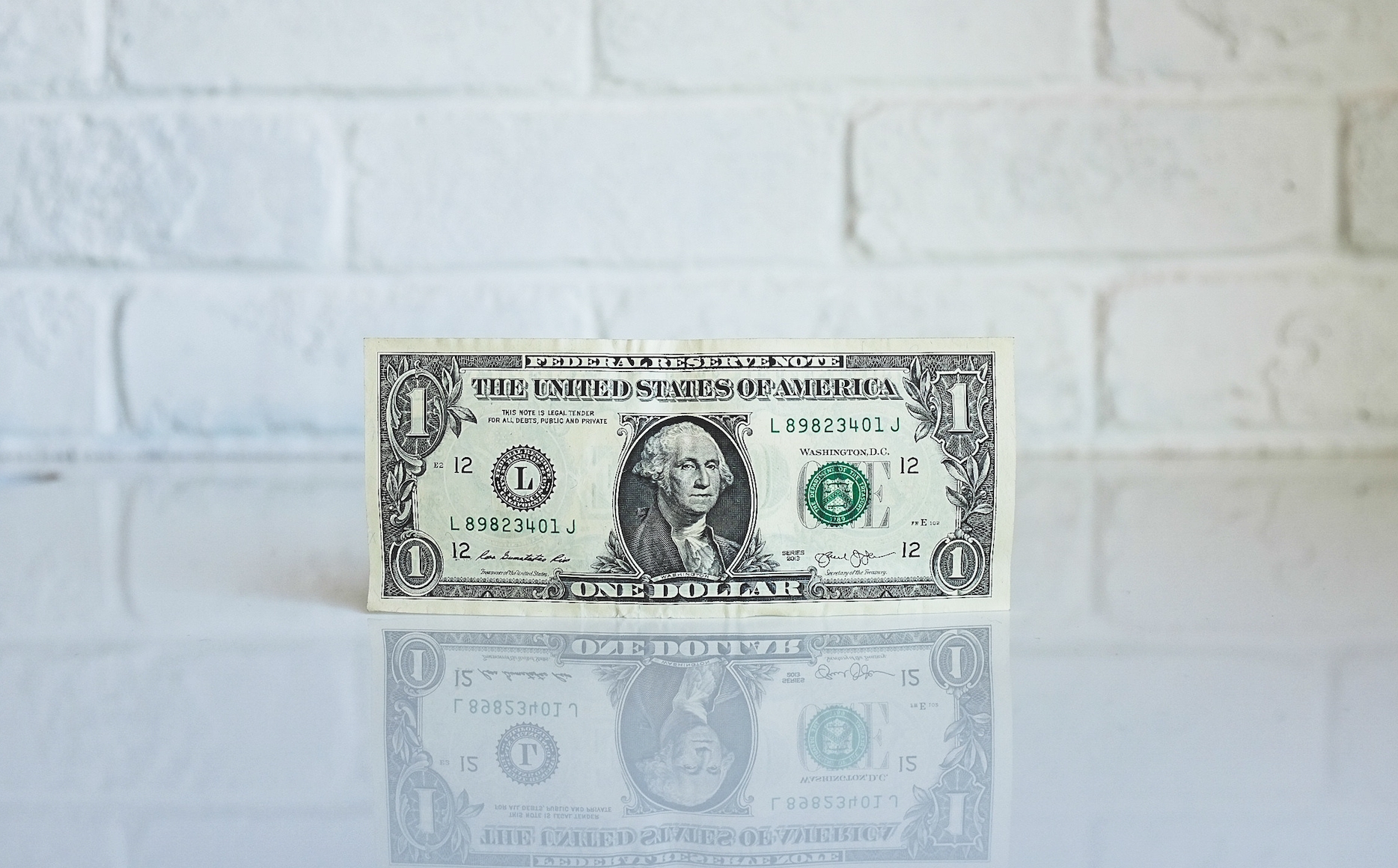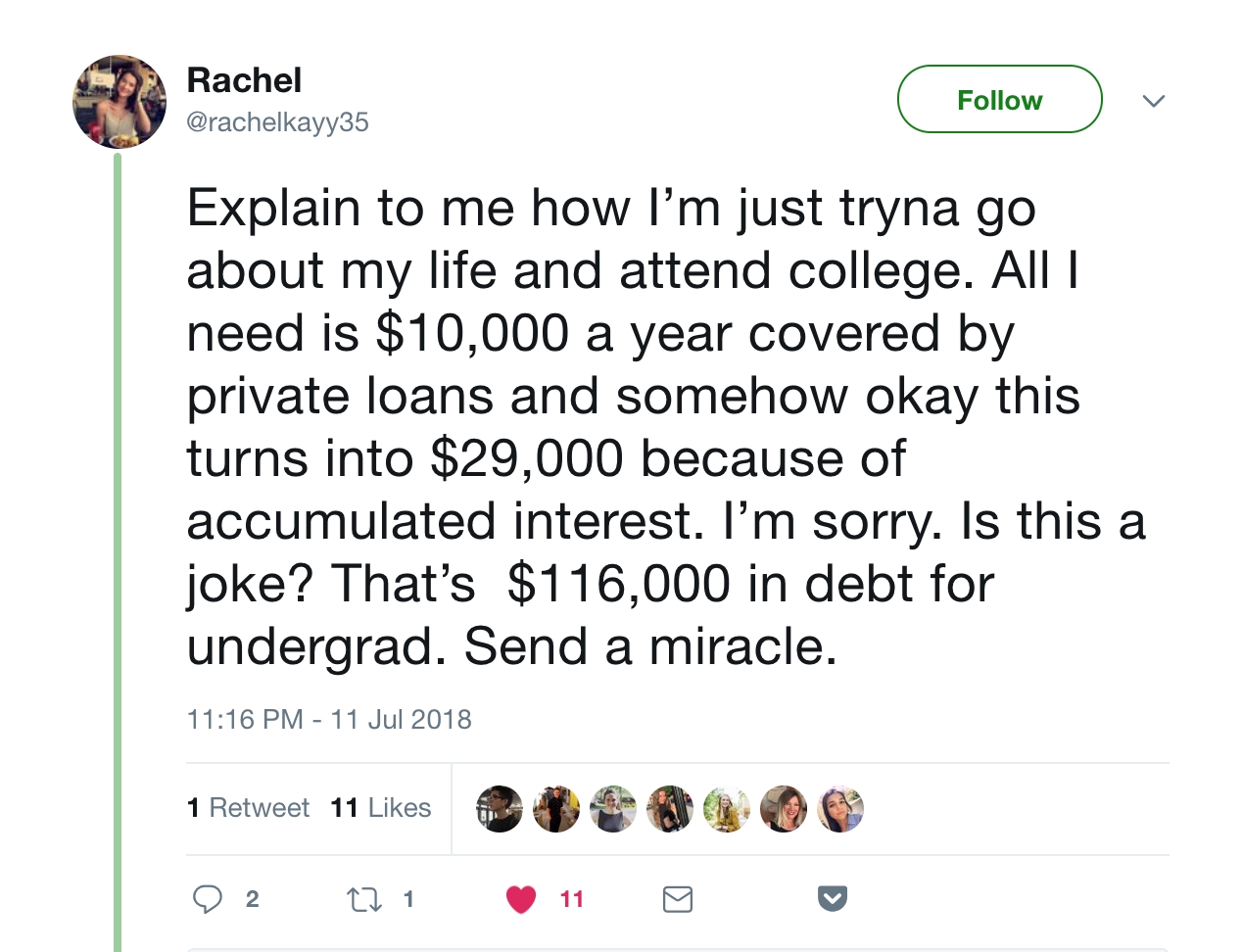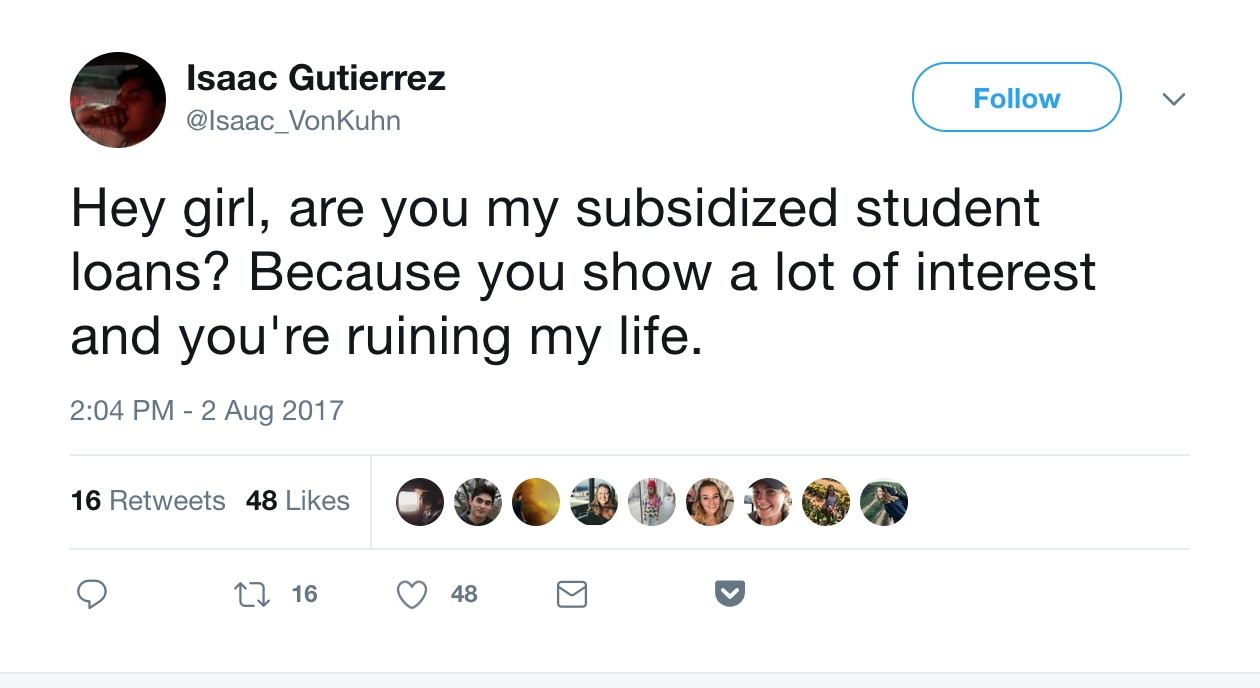
Do you remember where you were when you applied for your college loans? I do. I’d already arrived in Vermont for my first semester of an MFA program, but when the time came to sign my forms I felt overwhelmed by anxiety. I knew that a Master of Fine Arts – in fiction writing of all things – was for people with money to burn. It wasn’t the sort of degree that you pursued on credit, especially if you’d just finished paying your undergrad loans and didn’t have a co-signer.
Doctors, lawyers, and engineers take out huge sums for grad school. Not would-be novelists. And yet… I signed. Believing (as I still do) that it was the best path for me to chase my dreams.
“Where did they think you’d get the money to pay them back?” asks Thad Beversdorf, over the phone. Thad is a finance professor at Marquette University and the founder/CEO of SpendIndie.com. “That’s the thing: They knew you wouldn’t be able to. Any economist will tell you that.”
He’s not saying that the government doesn’t want us all to pay back our loans. The companies who service our debt will chase us to the literal ends of the earth to make sure that we do. But Beversdorf has made it his mission to help people understand that the financial transaction between the federal government as lender and we-the-broke-borrowers is a bit more complicated than it initially seems.
MISUNDERSTANDING THE POINT OF COLLEGE LOANS

“Every dollar printed by the Fed comes with a cash component and a debt component,” Beversdorf explains. “It’s the way our system is structured.”
Throughout the college loan boom – from roughly 1995 to present – corporations have often seen consumer spending falter, especially in key segments (like brick and mortar apparel). Wages have failed to keep pace with costs like healthcare, housing, and education, and people have less disposable cash on hand. Though GDP has steadily risen, money has been vacuumed out of the system by the 1% via stock dividends and buybacks. As a result, the economy is left competing with the stock market for a finite amount of capital.
So what happens when there’s less cash in circulation? The same thing that happens when you and 98 friends only have one pizza to split because one dude is hoarding twenty pizzas to himself — every bit becomes more precious and people are less likely to part with their share. When consumers are hesitant to spend, it has the potential to affect retail tremendously. Meanwhile, the cost of college has outpaced the growth of financial aid. These two seemingly disparate elements (lack of consumer spending and the student need to pay for college) fit together neatly — with the help of a financial instrument that’s grown both popular and necessary in recent decades: School loans.
“By printing money, the Fed was able to bolster consumer markets,” Beversdorf says. “Much of it through $1.5 trillion in student loans. Corporations were the big winner as those loans provided the cash to support growth. It was a free corporate bailout.”
Through loans, the debt was transferred to consumers. In this case a very reckless brand of consumers: College kids eager to buy beer, clothes, makeup, etc. And what did they find after graduation? A job market that had continued to weaken and was not particularly interested in their undergraduate degrees. They had gained skills, to be sure, but not enough to make them “in demand” in the workplace.
“The labor market is not characterized by a skills gap,” Marshall Steinbaum wrote for the Levy Institute earlier this year, in a paper modeling comprehensive student loan debt forgiveness. “The idea that it was, and that it could be solved by debt-financed higher education credentials, constitutes a macroeconomically significant misdiagnosis and false prescription.”
Translation: A simple college degree doesn’t help you make enough money to excuse the money borrowed plus interest. This seems like a major oversight by the Fed — unless, as Beversdorf points out, closing a perceived “skills gap” wasn’t the sole point of issuing the loans. While he understands it might sound horribly jaded to claim that the whole purpose of creating more than a trillion dollars in debt was to shift the cost of a corporate bailout onto college kids, seeing these same loans only as an act of bank-God altruism feels deeply naïve.
Especially when you consider the interest rates payees are on the hook for.
WHY YOU PAY SO MUCH INTEREST

“Since the bank bailout, the Fed, through its primary dealers, has loaned corporations trillions of dollars at artificially low interest rates,” Beversdorf says. “The hope was corporations would invest in business expansion here in the US but ultimately those low-cost loans were distributed directly to shareholders. Meanwhile, you’re paying… what? Eight percent after fees?”
He’s right. My blended interest rate after servicing fees is right around 8.2% over the current life of my loans. So it’s easy for me to reject the idea of the government as a benevolent force for students, especially knowing how much interest banks are currently making just off holding excess cash reserves for the Fed (12 billion!).
As always, Beversdorf says, the key here is to follow the money. If you use the accounting methods prescribed by the Federal Credit Reform Act of 1990 (FCRA), college loans create a budgetary surplus of $135 billion. But if you use the “Fair Value” method, that allows the government to carry the entire burden of risk and then accounts for potential defaults due to macroeconomic shifts, you get $88 billion in losses. While FCRA is what’s currently in place, even proponents of “fair value” recognize that — whether it creates a surplus or deficit — someone is making a lot of money on your student loans.
Who? Corporations like Navient. Big businesses that secure government contracts to manage student loans, add fees to the cost of the government interest rates (which are pegged to 10-year treasury notes), and will eagerly garnish your wages, snatch your tax returns, and forever burn down your credit if you try to default. Navient is also famously slick about hiding the best loan payback options, like income-driven repayment, and the details of loan forgiveness programs. The corporation (which, full disclosure, services my own loans) is currently being sued for deceptive business practices in California, Washington, Pennsylvania, and Illinois.
In the cruelest twist of fate, Navient is a publicly traded company and issues stock dividends to shareholders every quarter — thereby removing more cash from our system, keeping wages stagnant, and causing the need for future student loans.
THE CASE FOR ZERO PERCENT INTEREST

Before we get into the zero-percent interest argument, it’s worth noting that the very idea of slicing interest rates of current loans (and future loans, until the system is restructured) down to zero is not the most radical proposition in circulation these days. Not by a long shot. Complete loan forgiveness has actually gained a fair bit of traction in economic circles.
“I would point out,” Steinbaum writes, of the possibility of complete loan cancellation, “it amounts to around the same size in net dollar costs to the government as the recent tax giveaway to the rich, although with a very different beneficiary population. Hence, student debt cancellation would have a much better macroeconomic impact.”
Why is it better to invest in students than the mega-rich? Besides need, the answer is simple: Students and 20-somethings tend to keep their money in the system (buying things, saving, splurging, etc.), vs. the 1% whose money is leveraged to extract even more cash from circulation (stocks purchased and subsequent stock dividends received, etc.).
As Beversdorf explains, “Writing off those loans would actually complete the stimulus package that was started when the loans were issued. But, as the system currently stands, there would be too many strings attached for the ‘forgiven’ students – chains, really – to make it beneficial.”
An even more wild idea is a mass refusal to pay on the part of 40 million students. The implausibility of this is demonstrated by the inability of any text chain of four or more people to agree on where to eat for dinner, but that hasn’t stopped economists from exploring the massive impact that such a default would create. This scenario, which is virtually impossible, would be so destructive to the economy that it would actually make the very best option for the government to take the hit on the more than 1.3 trillion in outstanding loans.
Sure, it’s not gonna happen. But it’s fun to think, however fleetingly, that we, the people, have that sort of macroeconomic power, if we could just act in lockstep.
Zeroing out interest (or at the very least pegging total interest + fees to the inflation rate) feels far more realistic — even with current student loan rates on the rise. Obviously, it would cost the system money, but that ought not come from taxpayers. Corporations have benefitted from college students flush with cash for decades, the Federal Government has made money (under FCRA) off their interest, and loan servicers like Navient have profited off of them. The idea that these parties would be part of a student debt relief plan is perfectly reasonable and is, in fact, just a cost of doing business in a broken economic system where three human beings control more wealth than the bottom 50% of our nation. (In keeping with Beversdorf’s insistence that both sides of every economic transaction are considered, it’s interesting to wonder how many Microsoft or Apple computers were purchased with college loan money or how many ads have been surfaced for Facebook by students paying their wifi and phone bills with loans.)
“You could see the cost of 0% interest or even a complete loan write down as the end of the cycle from the original loan disbursement,” Beversdorf says. “They gave you money, you spent it, corporations kept it, and now the Federal government has to do something about it or face the same crisis they had in 2008 — a consumer base overwhelmed with debt and no reasonable means to pay it back.”
While zero percent interest sounds like a wild fantasy, it’s gaining a fair bit of traction in Canada. Students are campaigning across the country to slice interest rates to the bone and the entire province of Nova Scotia has already committed to doing exactly that for its residents.
“Eliminating the interest on provincial loans was our commitment from day one,” said Labour and Advanced Education Minister Kelly Regan, “and we’re keeping our promise to students.”
WHY 0% MATTERS

There are plenty of counterpoints against the cost involved in offering 0% interest to borrowers. First of all, Susan Dynarski, a senior fellow at the Brookings Institution, makes the point that the amount of money saved doesn’t help enough to speed up payoff rates significantly. She also notes that it’s a scattershot technique, that would benefit wealthy loan holders disproportionately.
There’s merit here. But students need some break. Something in a system where the entire borrowing set up (cosigners, lower rates with collateral, etc.) is embedded with all sorts of long-proven wealth, gender, and race-based biases and a majority of loans are held by black women.
“One thing that immediately becomes clear upon investigation of the student debt crisis,” Steinbaum writes, “is the extent to which it is a creature of this country’s legacy of racial discrimination, segregation, and economic disadvantage patterned by race.”
Dynarski doesn’t believe in loan forgiveness or lower-interest rates. Her case is for higher incomes for post-grad workers entering the job market. If corporations are finally ready to increase wages, no one is going to argue with that (the Economic Policy Institute calls raising pay “our central economic policy challenge”). But in the meantime, it seems worthwhile — if even just to make a dramatic statement — to create some sort of relief for current borrowers.
Especially since an extra hundred dollars a month in borrowers’ pockets would surely be at least partially filtered to retail markets and go toward supporting the economy.
“Contrarians are going to tell you that this is a ‘moral hazard risk,'” Beversdorf says. “Meaning that the fact that borrowers are getting a bailout now makes them more likely to need it again. But that’s exactly what happened in 2008. We saved banks, knowing that bailing them out might incentivize them to burn us again. If you bail out one but not the other, you’re picking winners and losers, as a government. And it becomes clear that their ‘winners’ are the banks and their ‘losers’ are the students.”
Beversdorf is alluding to the best argument of all for setting interest rates to zero: It’s a bet on students. It would loosen the anxiety that 67% of borrowers feel over their debts. It would give them a chance to think creatively rather than just about generating income. And it would allow them to build solid careers without having to race to keep up with climbing principal amounts. That’s why Nova Scotia did it. It wasn’t a short-term economic decision — viewed strictly as such, it’s not going to seem beneficial. It was an investment in the future and the government clearly understood the message that would send.
“We know that every dollar counts when graduates are beginning their careers,” Kelly Regan said, “and we hope this provides some relief to young people.”
Propositions like this are complicated. They deserve entire books but get 2,300-word essays. Who has time to read the books anyway? Not with interest accruing minute-by-minute (my own balance has increased more than $100 since I started this project last week). No wonder we have dystopian “loan payoff” game shows — people are desperate to catch a break.
To throw an idea like this in the ring is to invite backlash. But as Steinbaum writes in his Levy Institute conclusion, “A radical solution is what the status quo requires.” He’s writing about complete loan forgiveness, but Beversorf believes the same thought applies to a 0% interest rate.
“We can’t continue to feed consumers debt rather than income,” he tells me before hanging up. “Hoping by some miracle that everyone will just stumble over the money to repay their loans.”






